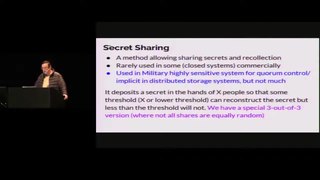
In cryptography, encryption is the process of encoding information. This process converts the original representation of the information, known as plaintext, into an alternative form known as ciphertext. Ideally, only authorized parties can decipher a ciphertext back to plaintext and access the original information. Encryption does not itself prevent interference but denies the intelligible content to a would-be interceptor.
Pretty Good Privacy (PGP) is an encryption program that provides cryptographic privacy and authentication for data communication. PGP is used for signing, encrypting, and decrypting texts, e-mails, files, directories, and whole disk partitions and to increase the security of e-mail communications. Phil Zimmermann developed PGP in 1991.

Philip R. Zimmermann is an American computer scientist and cryptographer. He is the creator of Pretty Good Privacy (PGP), the most widely used email encryption software in the world. He is also known for his work in VoIP encryption protocols, notably ZRTP and Zfone. Zimmermann is co-founder and Chief Scientist of the global encrypted communications firm Silent Circle.

Public-key cryptography, or asymmetric cryptography, is the field of cryptographic systems that use pairs of related keys. Each key pair consists of a public key and a corresponding private key. Key pairs are generated with cryptographic algorithms based on mathematical problems termed one-way functions. Security of public-key cryptography depends on keeping the private key secret; the public key can be openly distributed without compromising security.
A cypherpunk is any individual advocating widespread use of strong cryptography and privacy-enhancing technologies as a route to social and political change. Originally communicating through the Cypherpunks electronic mailing list, informal groups aimed to achieve privacy and security through proactive use of cryptography. Cypherpunks have been engaged in an active movement since at least the late 1980s.
In cryptography, the ElGamal encryption system is an asymmetric key encryption algorithm for public-key cryptography which is based on the Diffie–Hellman key exchange. It was described by Taher Elgamal in 1985. ElGamal encryption is used in the free GNU Privacy Guard software, recent versions of PGP, and other cryptosystems. The Digital Signature Algorithm (DSA) is a variant of the ElGamal signature scheme, which should not be confused with ElGamal encryption.
Articles related to cryptography include:
In cryptography, rubber-hose cryptanalysis is a euphemism for the extraction of cryptographic secrets from a person by coercion or torture—such as beating that person with a rubber hose, hence the name—in contrast to a mathematical or technical cryptanalytic attack.

The Clipper chip was a chipset that was developed and promoted by the United States National Security Agency (NSA) as an encryption device that secured "voice and data messages" with a built-in backdoor that was intended to "allow Federal, State, and local law enforcement officials the ability to decode intercepted voice and data transmissions." It was intended to be adopted by telecommunications companies for voice transmission. Introduced in 1993, it was entirely defunct by 1996.
Key management refers to management of cryptographic keys in a cryptosystem. This includes dealing with the generation, exchange, storage, use, crypto-shredding (destruction) and replacement of keys. It includes cryptographic protocol design, key servers, user procedures, and other relevant protocols.
Homomorphic encryption is a form of encryption that allows computations to be performed on encrypted data without first having to decrypt it. The resulting computations are left in an encrypted form which, when decrypted, result in an output that is identical to that produced had the operations been performed on the unencrypted data. Homomorphic encryption can be used for privacy-preserving outsourced storage and computation. This allows data to be encrypted and out-sourced to commercial cloud environments for processing, all while encrypted.
Cryptography is the practice and study of encrypting information, or in other words, securing information from unauthorized access. There are many different cryptography laws in different nations. Some countries prohibit export of cryptography software and/or encryption algorithms or cryptoanalysis methods. Some countries require decryption keys to be recoverable in case of a police investigation.
In cryptography, a hybrid cryptosystem is one which combines the convenience of a public-key cryptosystem with the efficiency of a symmetric-key cryptosystem. Public-key cryptosystems are convenient in that they do not require the sender and receiver to share a common secret in order to communicate securely. However, they often rely on complicated mathematical computations and are thus generally much more inefficient than comparable symmetric-key cryptosystems. In many applications, the high cost of encrypting long messages in a public-key cryptosystem can be prohibitive. This is addressed by hybrid systems by using a combination of both.

Jon Callas is an American computer security expert, software engineer, user experience designer, and technologist who is the co-founder and former CTO of the global encrypted communications service Silent Circle. He has held major positions at Digital Equipment Corporation, Apple, PGP, and Entrust, and is considered "one of the most respected and well-known names in the mobile security industry." Callas is credited with creating several Internet Engineering Task Force (IETF) standards, including OpenPGP, DKIM, and ZRTP, which he wrote. Prior to his work at Entrust, he was Chief Technical Officer and co-founder of PGP Corporation and the former Chief Technical Officer of Entrust.

Cryptography, or cryptology, is the practice and study of techniques for secure communication in the presence of adversarial behavior. More generally, cryptography is about constructing and analyzing protocols that prevent third parties or the public from reading private messages. Modern cryptography exists at the intersection of the disciplines of mathematics, computer science, information security, electrical engineering, digital signal processing, physics, and others. Core concepts related to information security are also central to cryptography. Practical applications of cryptography include electronic commerce, chip-based payment cards, digital currencies, computer passwords, and military communications.

Mordechai M. "Moti" Yung is a cryptographer and computer scientist known for his work on cryptovirology and kleptography.
Silent Circle is an encrypted communications firm based in Washington DC. Silent Circle provides multi-platform secure communication services for mobile devices and desktop. Launched October 16, 2012, the company operates under a subscription business model. The encryption part of the software used is free software/open source and peer-reviewed. For the remaining parts of Silent Phone and Silent Text, the source code is available on GitHub, but under proprietary software licenses.
The Silent Circle Instant Message Protocol (SCIMP) was an encryption scheme that was developed by Vincent Moscaritolo of Silent Circle. It enabled private conversation over instant message transports such as XMPP (Jabber).

Attempts, unofficially dubbed the "Crypto Wars", have been made by the United States (US) and allied governments to limit the public's and foreign nations' access to cryptography strong enough to thwart decryption by national intelligence agencies, especially the National Security Agency (NSA).

Hugo Krawczyk is an Argentine-Israeli cryptographer best known for co-inventing the HMAC message authentication algorithm and contributing in fundamental ways to the cryptographic architecture of central Internet standards, including IPsec, IKE, and SSL/TLS, in particular, both IKEv2 and TLS 1.3 use Krawczyk’s SIGMA protocol as the cryptographic core of their key exchange procedures. He has also contributed foundational work in the areas of threshold and proactive cryptosystems and searchable symmetric encryption, among others.








